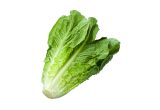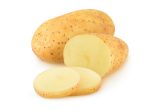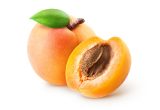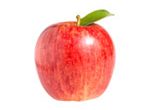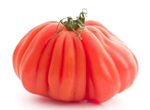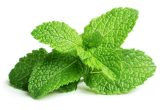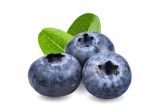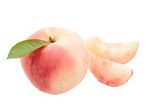Nectarine (yellow)

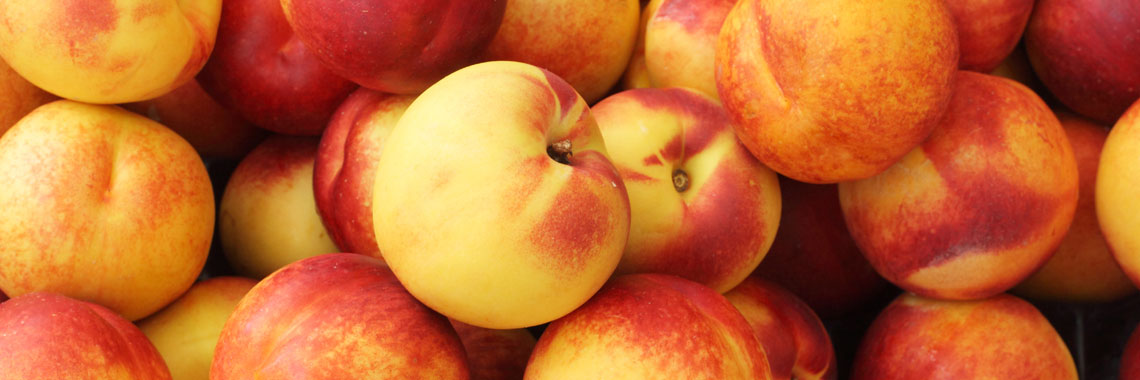
Description
- The yellow nectarine grows on a nectarine tree which belongs to the Rosaceae family, genus Prunus, species persica (Ravaglia, 2013).
- The yellow nectarine is a smooth-skinned peach variety (Aubert, 2003a).
PHYSICAL AND ORGANOLEPTIC CHARACTERISTICS
- Fruit firmness increases during the first 4-6 weeks after flowering and then decreases from the sixth week (Su, 2012).
- The red pigmentation of nectarine skin is due to the presence of cyanidins (anthocyanins) and more particularly cyanidin-3-glucoside and cyanidin 3-rutoside (Ravaglia, 2013). Their concentration decreases from the fourth to the eighth week after flowering, then increases from the eighth to the twelfth week (Su, 2012).
- According to a study conducted on two nectarine cultivars, ripe nectarines with the highest density have significantly higher levels of sugars (up to 40%) and lactones (up to 3 times) and are therefore judged to be sweeter and more aromatic than those with a lower density Their vitamin C content is also higher when they are ripe and of higher density (Aubert, 2019).
- Another study showed that sucrose levels in yellow nectarines increase significantly with ripening, while titratable acidity levels, including citric acid, decrease significantly (Aubert, 2003b).
COMPOSITION CHARACTERISTICS (excluding macronutrients, vitamins and minerals)
- The nectarine is an important source of polyphenols with antioxidant properties. The phytochemical profile of the fruit varies according to the cultivars (Cantin, 2009). Its flavonoid and anthocyanin composition increases during fruit growth and ripening (Ravaglia, 2013).
RAW
The following values are approximate and depend on variety, season, ripeness, cultivation conditions, etc.
The yellow nectarine (with skin) brings on average 51.30 calories (kcal) for 100 g, i.e. 218 kJ.
COMPOSITION TABLES
For each nutrient, the tables provide information on the content, minimum and maximum values, as well as the percentage of Dietary Reference Values (DRVs) per 100 g net of yellow nectarine, pulp and skin, raw.
MACRONUTRIENTS
| Constituent (g) | Average content |
Min-Max per 100g |
DRV% |
|---|---|---|---|
| Water | 86,6 | - | - |
| Fibers | 0,60 | - | - |
| Carbohydrates | 11,30 | - | 4,35 |
| Sugars | 8,80 | - | 9,78 |
| Lipids | < 0,50 | - | - |
| Saturated fat | < 0,01 | - | - |
| Protein | 0,69 | NC - 0,70 | 1,38 |
| Constituent (g) | Amount | Min-Max | DRV% |
|---|---|---|---|
| Water | Ciqual 2020 (valeur issue des analyses Ciqual-Aprifel 2017) | - | - |
| Fibers | Ciqual 2020 (valeur issue des analyses Ciqual-Aprifel 2017) | - | - |
| Carbohydrates | Ciqual 2020 | - | Règlement (UE) N°1169/2011 du parlement Européen et du conseil du 25 octobre 2011 |
| Sugars | Ciqual 2020 (valeur issue des analyses Ciqual-Aprifel 2017) | - | Règlement (UE) N°1169/2011 du parlement Européen et du conseil du 25 octobre 2011 |
| Lipids | Ciqual 2020 (valeur issue des analyses Ciqual-Aprifel 2017) | - | Règlement (UE) N°1169/2011 du parlement Européen et du conseil du 25 octobre 2011 |
| Saturated fat | Ciqual 2020 (valeur issue des analyses Ciqual-Aprifel 2017) | - | Règlement (UE) N°1169/2011 du parlement Européen et du conseil du 25 octobre 2011 |
| Protein | Ciqual 2020 (valeur issue des analyses Ciqual-Aprifel 2017) | - | Règlement (UE) N°1169/2011 du parlement Européen et du conseil du 25 octobre 2011 |
Zoom on carbohydrates
- The energy of the yellow nectarine comes essentially from its carbohydrates, at 11.30 g per 100 g
- This amount is equivalent to the average amount found in raw fruit: about 11.31 g per 100 g.
- These are essentially sucrose (6.60 g per 100 g), fructose (1.20 g per 100 g), and glucose (1 g per 100 g).
Zoom on fibres
- The yellow nectarine contains a lower amount of fibre (0.60 g per 100 g) than the average amount present in raw fruit (2.77 g per 100 g).
Zoom on proteins
- Its amount of proteins (0.69 g per 100 g) is lower than the average amount present in fresh fruit (0.93 g per 100 g).
Zoom on lipids
- The yellow nectarine is fat-free* as it contains less than 0.5 g per 100 g.
* Regulation (EC) No 1924/2006 of the European Parliament and of the Council of 20 December 2006 on nutrition and health claims made on foods
MINERALS AND TRACE ELEMENTS
| Constituent | Average content |
Min-Max per 100g |
DRV% |
|---|---|---|---|
| Calcium (mg) | 4,80 | - | 0,60 |
| Chloride (mg) | < 20 | - | - |
| Copper (mg) | 0,06 | - | 6 |
| Iron (mg) | 0,13 | - | 0,93 |
| Iodine (µg) | < 20 | - | - |
| Magnesium (mg) | 8 | - | 2,13 |
| Manganese (mg) | 0,05 | - | 2,50 |
| Phosphorus (mg) | 19 | - | 2,71 |
| Potassium (mg) | 220 | - | 11 |
| Selenium (µg) | < 20 | - | - |
| Sodium (mg) | < 5 | - | - |
| Zinc (mg) | 0,11 | - | 1,10 |
| Constituent | Amount | Min-Max | DRV% |
|---|---|---|---|
| Calcium (mg) | Ciqual 2020 (valeur issue des analyses Ciqual-Aprifel 2017) | - | Règlement (UE) N°1169/2011 du parlement Européen et du conseil du 25 octobre 2011 |
| Chloride (mg) | Ciqual 2020 (valeur issue des analyses Ciqual-Aprifel 2017) | - | Règlement (UE) N°1169/2011 du parlement Européen et du conseil du 25 octobre 2011 |
| Copper (mg) | Ciqual 2020 (valeur issue des analyses Ciqual-Aprifel 2017) | - | Règlement (UE) N°1169/2011 du parlement Européen et du conseil du 25 octobre 2011 |
| Iron (mg) | Ciqual 2020 (valeur issue des analyses Ciqual-Aprifel 2017) | - | Règlement (UE) N°1169/2011 du parlement Européen et du conseil du 25 octobre 2011 |
| Iodine (µg) | Ciqual 2020 (valeur issue des analyses Ciqual-Aprifel 2017) | - | Règlement (UE) N°1169/2011 du parlement Européen et du conseil du 25 octobre 2011 |
| Magnesium (mg) | Ciqual 2020 (valeur issue des analyses Ciqual-Aprifel 2017) | - | Règlement (UE) N°1169/2011 du parlement Européen et du conseil du 25 octobre 2011 |
| Manganese (mg) | Ciqual 2020 (valeur issue des analyses Ciqual-Aprifel 2017) | - | Règlement (UE) N°1169/2011 du parlement Européen et du conseil du 25 octobre 2011 |
| Phosphorus (mg) | Ciqual 2020 (valeur issue des analyses Ciqual-Aprifel 2017) | - | Règlement (UE) N°1169/2011 du parlement Européen et du conseil du 25 octobre 2011 |
| Potassium (mg) | Ciqual 2020 (valeur issue des analyses Ciqual-Aprifel 2017) | - | Règlement (UE) N°1169/2011 du parlement Européen et du conseil du 25 octobre 2011 |
| Selenium (µg) | Ciqual 2020 (valeur issue des analyses Ciqual-Aprifel 2017) | - | Règlement (UE) N°1169/2011 du parlement Européen et du conseil du 25 octobre 2011 |
| Sodium (mg) | Ciqual 2020 (valeur issue des analyses Ciqual-Aprifel 2017) | - | - |
| Zinc (mg) | Ciqual 2020 (valeur issue des analyses Ciqual-Aprifel 2017) | - | Règlement (UE) N°1169/2011 du parlement Européen, et du conseil du 25 octobre 2011 |
Zoom on minerals and trace elements
- The yellow nectarine provides a significant amount of potassium, equivalent to 11% of DRVs, i.e. 220 mg per 100 g.
- It also provides the equivalent of 6% of DRVs for copper, i.e. 0.06 mg per 100 g.
- The other minerals and trace elements are present in lesser quantities as they represent less than 3% of DRVs.
VITAMINS
| Constituent | Average content |
Min-Max per 100g |
DRV% |
|---|---|---|---|
| Provitamin A Beta-carotene (µg) | 144 | - | - |
| Vitamin A equivalent (µg) | 24 | - | 3 |
| Vitamin B1 (mg) | < 0,015 | - | - |
| Vitamin B2 (mg) | < 0,01 | - | - |
| Vitamin B3 (mg) | 0,56 | - | 3,50 |
| Vitamin B5 (mg) | 0,22 | - | 3,67 |
| Vitamin B6 (mg) | < 0,01 | - | - |
| Vitamin B9 (µg) | 8,40 | - | 4,20 |
| Vitamin C (mg) | 3,38 | - | 4,23 |
| Vitamin E (mg) | < 0,08 | - | - |
| Vitamin K1 (µg) | < 0,80 | - | - |
| Constituent | Amount | Min-Max | DRV% |
|---|---|---|---|
| Provitamin A Beta-carotene (µg) | Ciqual 2020 (valeur issue des analyses Ciqual-Aprifel 2017) | - | - |
| Vitamin A equivalent (µg) | Calcul à partir de la valeur Provitamine A Béta-carotène* | - | Règlement (UE) N°1169/2011 du parlement Européen et du conseil du 25 octobre 2011 |
| Vitamin B1 (mg) | Ciqual 2020 (valeur issue des analyses Ciqual-Aprifel 2017) | - | Règlement (UE) N°1169/2011 du parlement Européen, et du conseil du 25 octobre 2011 |
| Vitamin B2 (mg) | Ciqual 2020 (valeur issue des analyses Ciqual-Aprifel 2017) | - | Règlement (UE) N°1169/2011 du parlement Européen et du conseil du 25 octobre 2011 |
| Vitamin B3 (mg) | Ciqual 2020 (valeur issue des analyses Ciqual-Aprifel 2017) | - | Règlement (UE) N°1169/2011 du parlement Européen, et du conseil du 25 octobre 2011 |
| Vitamin B5 (mg) | Ciqual 2020 (valeur issue des analyses Ciqual-Aprifel 2017) | - | Règlement (UE) N°1169/2011 du parlement Européen et du conseil du 25 octobre 2011 |
| Vitamin B6 (mg) | Ciqual 2020 (valeur issue des analyses Ciqual-Aprifel 2017) | - | Règlement (UE) N°1169/2011 du parlement Européen et du conseil du 25 octobre 2011 |
| Vitamin B9 (µg) | Ciqual 2020 (valeur issue des analyses Ciqual-Aprifel 2017) | - | Règlement (UE) N°1169/2011 du parlement Européen et du conseil du 25 octobre 2011 |
| Vitamin C (mg) | Ciqual 2020 (valeur issue des analyses Ciqual-Aprifel 2017) | - | Règlement (UE) N°1169/2011 du parlement Européen et du conseil du 25 octobre 2011 |
| Vitamin E (mg) | Ciqual 2020 | - | Règlement (UE) N°1169/2011 du parlement Européen et du conseil du 25 octobre 2011 |
| Vitamin K1 (µg) | Ciqual 2020 (valeur issue des analyses Ciqual-Aprifel 2017) | - | Règlement (UE) N°1169/2011 du parlement Européen et du conseil du 25 octobre 2011 |
Zoom on vitamins
- The yellow nectarine provides the equivalent of:
- 4.23% of DRVs for vitamin C, i.e. 3.38 mg per 100 g;
- 4.20% of DRVs for vitamin B9, i.e. 8.40 µg per 100 g.
- The other vitamins are present in smaller quantities, since they cover less than 4% of DRVs.
* Calculation made: Beta Carotene / 6 + retinol
POLYPHENOLS
| Constituent (mg) | Average content |
Min-Max per 100mg |
|---|---|---|
| Flavonoids (mg) | 1,82 | - |
| of which Flavonols (mg) | 1,22 | - |
| of which Flavanols (mg) | 0,60 | - |
| of which Anthocyanins (mg) | 2,95 | - |
| Phenolic Acids (mg) | 10,10 | - |
| of which Hydroxycinnamic acids (mg) | 10,10 | - |
| Total polyphenols | 14,87 | - |
| Constituent (mg) | Amount | Min-Max |
|---|---|---|
| Flavonoids | Etude CTIFL-Aprifel 2017-2018- Méthode utilisée : chromatographie | - |
| of which Flavonols | Etude CTIFL-Aprifel 2017-2018- Méthode utilisée : chromatographie | - |
| of which Flavanols | Etude CTIFL-Aprifel 2017-2018- Méthode utilisée : chromatographie | - |
| of which Anthocyanins | Etude CTIFL-Aprifel 2017-2018- Méthode utilisée : chromatographie | - |
| Phenolic Acids | Etude CTIFL-Aprifel 2017-2018- Méthode utilisée : chromatographie | - |
| of which Hydroxycinnamic acids | Etude CTIFL-Aprifel 2017-2018- Méthode utilisée : chromatographie | - |
| Total polyphenols | Etude CTIFL-Aprifel 2017-2018- Méthode utilisée : chromatographie | - |
Zoom on polyphenols
- Polyphenols are substances with an antioxidant effect.
- Hydroxycinnamic acids, which are part of the phenolic acids, are predominantly present in yellow nectarine composites, representing 68% of the total polyphenols identified.
- Next come the anthocyanins (20% of total polyphenols).
- Flavonols and flavanols represent 8% and 4% of total polyphenols respectively.
Nutrition and health claims
According to the definitions of nutrition claims as set out in Regulation (EC) No 1924/2006 on nutrition and health claims, and in view of the composition of the yellow nectarine (pulp and skin), the following claims may be used:
NUTRITION CLAIMS OF YELLOW NECTARINE
- Fat-free (100 g of yellow nectarine do not contain more than 0.5 g of fat)
References
- Agence nationale de sécurité sanitaire de l’alimentation, de l’environnement et du travail. Table de composition nutritionnelle des aliments Ciqual 2020. Consultée le 27/08/2020 depuis le site internet Ciqual https://ciqual.anses.fr/
- Aubert C, Chalot G, Lurol S, Ronjon A, Cottet V. Relationship between fruit density and quality parameters, levels of sugars, organic acids, bioactive compounds and volatiles of two nectarine cultivars, at harvest and after ripening. Food Chemistry. 2019;(297):124954.
- (a)Aubert C, Gu-Nata Z, Ambid C and Baumes R. Changes in Physicochemical Characteristics and Volatile Constituents of Yellow- and White-Fleshed Nectarines during Maturation and Artificial Ripening. J. Agric. Food Chem. 2003;(51):3083-91.
- (b)Aubert C, Ambid C, Baumes R and Gu-Nata Z. Investigation of Bound Aroma Constituents of Yellow-Fleshed Nectarines (Prunus persica L. Cv. Springbright). Changes in Bound Aroma Profile during Maturation. J. Agric. Food Chem. 2003;(51):6280-86.
- Cantín CM, Moreno MA, Gogorcena Y. Evaluation of the antioxidant capacity, phenolic compounds, and vitamin C content of different peach and nectarine [Prunus persica (L.) Batsch] breeding progenies. J Agric Food Chem. 2009;57(11):4586-92.
- Ravaglia D, Espley RV, Henry-Kirk RA, Andreotti C, Ziosi V, Hellens RP, Costa G, Allan AC. Transcriptional regulation of flavonoid biosynthesis in nectarine (Prunus persica) by a set of R2R3 MYB transcription factors. BMC Plant Biol. 2013;13:68.
- Règlement (CE) N° 1924/2006 du Parlement européen et du Conseil du 20 décembre 2006 concernant les allégations nutritionnelles et de santé portant sur les denrées alimentaires.
- Règlement (UE) N°432/2012 de la Commission du 16 mai 2012 établissant une liste des allégations de santé autorisées portant sur les denrées alimentaires, autres que celles faisant référence à la réduction du risque de maladie ainsi qu’au développement et à la santé infantiles.
- Règlement (UE) n°1169/2011 du Parlement européen et du Conseil du 25 octobre 2011 concernant l’information des consommateurs sur les denrées alimentaires, modifiant les règlements (CE) n°1924/2006 et (CE) n°1925/2006 du Parlement européen et de Conseil et abrogeant la directive 87/250/CEE de la Commission, la directive 90/496/CEE du Conseil, la directive 1999/10/CE de la Commission, la directive 200/13/CE du Parlement européen et du Conseil, les directives 2002/67/CE et 2008/5/CE de la Commission et le règlement (CE) n°608/2004 de la Commission.
- Su M, Chen K, Ye Z, Zhang B, Guo J, Xu C, Sun C, Zhang J, Li X, Wu A, Xi W. Physical changes and physiological characteristics of red and green peel during nectarine (cv. Hu018) maturation. J Sci Food Agric. 2012;92(7):1448-54.





